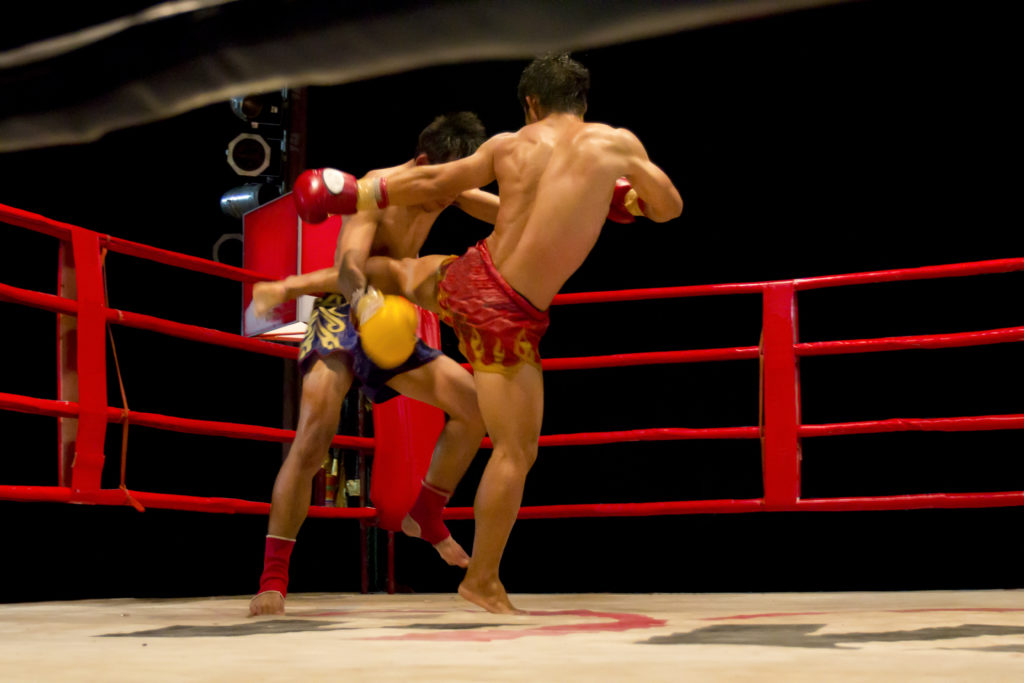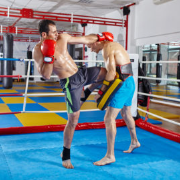Here are 6 essential muay thai combos I like to train, which are also used by pro fighters in the ring.
There are any number of combinations you can develop and chain together and combine with your favorite techniques.
This can be dependent on your style and your strengths.
In comparison to kickboxing combos, these muay thai combos make use of the muay thai clinch and elbows which are not used in some professional kickboxing promotions.
So, the 6 muay thai combos I like to use are detailed below and are :
- Jab – Jab, Cross – Rear Knee
- Jab – Lead Teep – Rear Kick
- Jab, Cross – Switch Knee – Rear Elbow
- Jab, Rear Uppercut, Lead Hook – Rear Body Kick
- Jab, Cross, Liver shot – Rear Head Kick
- Jab – Cross – Lead Knee – Clinch
1. Jab – Jab, Cross – Rear Knee
This is a combo I really like and it makes use of broken rhythm.
The first Jab is to get your opponent wary of your lead hand.
The first two jabs are not double jabs in succession. There is a short gap between your first Jab and the next 1-2 combo of Jab, Cross.

Next your lead hand goes out like a Jab but really you just want to control your opponents lead hand and your rear hand will go on their head or shoulder/neck area with your chin tucked behind the rear shoulder and head down.
Pull down on your opponents head/neck area and throw the rear knee to the body.
The key to this muay thai combo is that after the first three punches your lead hand goes out like a punch but just to control your opponents hands and your rear hand grabs around their head/neck area to allow for your rear knee.
2. Jab – Lead Teep – Rear Kick
This muay thai combo makes use of your longest weapons which are your Jab and your Lead Teep or Pushkick.
Two attacks from your lead side and then follow with the rear kick to the body.
A relatively simple combo but this is one that works and is great to practice on the heavy bag to perfect.
After landing your lead teep, your lead leg should plant stright down after and make sure to turn on that lead foot to get the power in the rear kick.
The video above shows Jap – Lead Teep – Rear Knee. But you can get the idea. Notice how the lead foot comes straight down to allow for the rear kick to be thrown.
The main aspect of the video above is the timing of the three strikes which is what we are after with this combo.
3. Jab, Cross – Switch Knee – Rear Elbow
Knee to Elbow is a common combination in muay thai. This is because the knee and elbow are executed in similar range.
Here we want the Jab. Cross to make our opponent shell up or become more defensive to set up the Switch Knee.
After the Switch Knee, the lead foot lands straight down and our power will come from the rear side for the rear elbow.
4. Jab, Rear Uppercut, Lead Hook – Rear Body Kick
In the Bang Muay Thai system this is called the ‘Sticks Combo’ and it finishes with a head kick.
I like the body kick to score quickly and the head kick to damage the opponent and go for the KO.
In the Bang Muay Thai system a key punching strategy is:
Straight shots set up round shots - Round shots set up straight shots
So an effective Jab can help set up the Uppercut which will also help set up the Hook to the Head.
This combination punching will also allow for setting up your Rear Body Kick.
5. Jab, Cross, Liver shot – Rear Head Kick
Similar to the combo just above. Three punches to set up the rear kick are used.
But here we use the body hook or Liver Shot if Ortho vs Ortho stance as in the video below.
As stated above – Straight shots can set up your round shots. Another key strategy in the Bang Muay Thai system is:
Shots to the Head set up shots to the Body
The Liver shot can break your opponents posture and really hurt them and make them lean to their side and lower their head.
This sets up the rear head kick which can be a KO for you!
6. Jab – Cross – Lead Knee – Clinch
Here we make use of the muay thai clinch.
The Jab initiates and the Cross that follows is really just to get your hand around your opponents back of their head.
So the Straight Cross is really just to allow you to enter the clinch in a safer position with your chin protected behind your rear straight arm.
Your lead arm after you throw the Jab will look to control your opponents rear hand for more protection to enter the clinch.
Following the Lead Knee your lead arm will go the back of your opponents neck area.
Your rear arm will go inside their lead arm at the elbow/bicep area for inside control.
With good inside control you can then throw the Rear Uppercut Elbow to the chin.
In the video below, Petchboonchu shows Shane Fazen his favored methods for entering the clinch safely which pretty much is the same as what I describe above.
Training these Muay Thai Combos
Each of these combos could and should be trained and practiced in shadow boxing, heavy bag training, partner drills and then eventually implemented in your sparring and competing.
Shadow boxing these combos is to developed the body mechanics and muscle memory and to memorize the actual combinations.
The heavy bag is where you develop more power in each of these techniques and chain them together in the combos.
Partner drilling is to develop your accuracy, timing and defense awareness, before, during and after the combinations.
Sparring is where you can test them out to eventually pull them off in a competition if that is your goal.




